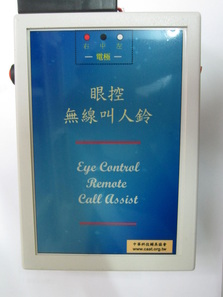eye controlled call assist
Basic Description
Device Name: Eye Controlled Call Assist
Supplier: Icebreaker Team
Website:Icebreaker Website
Product Description
The device was specifically designed in response to a need for ALS clients, whose only residual movement is eye movement, but who wish to have some means for calling for assistance. Three small electrodes are attached to the head using conductive paste. These electrodes can detect the very small EOG signal that is generated when the eyes move from right to left or vice-versa. When this small signal is amplified it can be used to activate a request for help signal on the remote receiver. By moving the eyes in a certain right-left pattern to activate the request for help signal, normal eye movement will not generate erroneous call signals. The device is battery powered.
Specification
Size: Transmitter - 18cm x 13cm x 5cm Receiver - 8cm x 6cm x 2cm
Power: Transmitter - Three AA batteries Receiver - Two AA batteries
Low Transmitter Battery Indicator
Wireless operation
Adjustable eye activating signal to suit different disability levels
Suitable For
Advantages
Disadvantages
Icebreaker Team Comments
The Icebreaker Team designed this device in response to a great need from people with locked in ALS to generate a simple request for help. It is usually used during the night when carers might be asleep and other Assistive Technology devices, such as eye controlled computers may be switched off. Although the population who use this device is very small, confined only to those with locked in ALS, its importance still makes it an important device in our assessment work. It is also stressed that under no conditions is the device to be considered for use in emergency situations.
Device Name: Eye Controlled Call Assist
Supplier: Icebreaker Team
Website:Icebreaker Website
Product Description
The device was specifically designed in response to a need for ALS clients, whose only residual movement is eye movement, but who wish to have some means for calling for assistance. Three small electrodes are attached to the head using conductive paste. These electrodes can detect the very small EOG signal that is generated when the eyes move from right to left or vice-versa. When this small signal is amplified it can be used to activate a request for help signal on the remote receiver. By moving the eyes in a certain right-left pattern to activate the request for help signal, normal eye movement will not generate erroneous call signals. The device is battery powered.
Specification
Size: Transmitter - 18cm x 13cm x 5cm Receiver - 8cm x 6cm x 2cm
Power: Transmitter - Three AA batteries Receiver - Two AA batteries
Low Transmitter Battery Indicator
Wireless operation
Adjustable eye activating signal to suit different disability levels
Suitable For
- ALS users with only residual eye movement
Advantages
- Easy installation
- Battery power for safety
- Reliable operation
- Wireless operation
Disadvantages
- Requires electrode contact with skin
Icebreaker Team Comments
The Icebreaker Team designed this device in response to a great need from people with locked in ALS to generate a simple request for help. It is usually used during the night when carers might be asleep and other Assistive Technology devices, such as eye controlled computers may be switched off. Although the population who use this device is very small, confined only to those with locked in ALS, its importance still makes it an important device in our assessment work. It is also stressed that under no conditions is the device to be considered for use in emergency situations.

